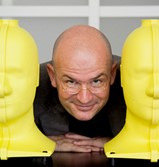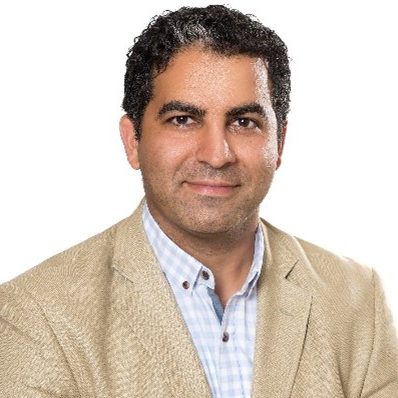Near-field Radiometry for Internal Body Temperature Monitoring
Prof. Zoya Popovic, University of Colorado Boulder
This talk presents the fundamentals of operation, design, implementation and testing of a microwave radiometer for near-field internal temperature measurements of the human body. In this approach, the total blackbody power from a tissue stack is received by a 1.4-GHz probe placed on the skin connected to a low-noise receiver. Temperature retrieval for sub-surface tissue layers is performed using near-field weighting functions, obtained by full-wave simulations with known tissue complex electrical parameters. Measurements are presented using several types of calibrated radiometers at 1.4GHz for various phantom tissues and in-vivo tracking in the human cheek is also shown to follow ground-truth thermocouple measurements. With an integration time on the order of a second, temperature can be tracked within a fraction of a degree. Several medical applications are outlined along with their respective technical challenges. These range from brain temperature monitoring during aortic repair open-heart surgery to monitoring soldiers under heavy training.

Zoya Popovic is a Distinguished Professor and the Lockheed Martin Endowed Chair of Electrical Engineering at the University of Colorado. She obtained her Dipl.Ing. degree at the University of Belgrade, Serbia, and her Ph.D. at Caltech. She holds an honorary PhD from the Carlos III University in Madrid, Spain. She has graduated over 70 PhD students and currently advises 18 graduate students in various areas of high-frequency electronics and microwave engineering. She is a Fellow of the IEEE and the recipient of two IEEE MTT Microwave Prizes for best journal papers, the White House NSF Presidential Faculty Fellow award, the URSI Issac Koga Gold Medal, the ASEE/HP Terman Medal and the German Humboldt Research Award. She was named IEEE MTT Distinguished Educator in 2013 and a Distinguished Research Lecturer of the University of Colorado in 2016. She is a Member of the National Academy of Engineering (2022). She has a husband physicist and three daughters who can all solder.
Wireless Medical Diagnostics and Therapeutic Systems
Prof. John Rogers, Northwestern University
Advanced electronic/optoelectronic technologies that allow stable, intimate integration with living organisms will accelerate progress in biomedical research; they will also serve as the foundations for new approaches in monitoring and treating diseases. Specifically, capabilities for injecting miniaturized semiconductor devices and other components into soft tissues or for softly laminating them onto the surfaces of vital organs will open up unique and important opportunities in tracking and manipulating biological processes. This presentation describes the core concepts, with an emphasis on wireless power and communication strategies, that underpin these types of technologies, including those that are designed to disappear by resorption into the body on timescales matched to natural processes. Examples include skin-like devices for health monitoring and bioelectronic ‘medicines’ for neuroregeneration and temporary cardiac pacing.

Professor John A. Rogers began his career at Bell Laboratories as a Member of Technical Staff in the Condensed Matter Physics Research Department in 1997 and served as Director from the end of 2000 to 2002. He then spent thirteen years at the University of Illinois, as the Swanlund Chair Professor and Director of the Seitz Materials Research Laboratory. In 2016, he joined Northwestern University as the Simpson/Querrey Professor, where he is also Director of the Institute for Bioelectronics. He has co-authored nearly 900 papers and he is co-inventor on more than 100 patents. His research has been recognized by many awards, including a MacArthur Fellowship (2009), the Lemelson-MIT Prize (2011), the Smithsonian Award for American Ingenuity in the Physical Sciences (2013), the Benjamin Franklin Medal (2019), and a Guggenheim Fellowship (2021). He is a member of the National Academy of Engineering, the National Academy of Sciences, the National Academy of Medicine and the American Academy of Arts and Sciences.
In Silico Methods: Engineering Therapies for Precision Healthcare
Prof. Niels Kuster, IT’IS Foundation / ETH Zurich
The development of novel medical technologies and therapies to treat conditions or restore lost physiological functions using personalized, precision medicine approaches is a slow and expensive process. The agent (e.g., the electromagnetic field from an electroceutical) and the physiological response (e.g., spike initiation locations and recruitment curves, organ responses, etc.) must to be accurately quantified to allow for treatment optimization while safety is ensured. In addition, personalization of treatment requires a detailed understanding of how intersubject variability (in terms of body morphology and health status) influences outcomes. In silico methods offer a unique means to address these needs and significantly improve patient quality-of-life by (i) accelerating proof of concept for novel healthcare solutions, (ii) enabling virtual testing of medical device prototypes prior to expensive laboratory testing, (iii) fostering virtual translational studies to identify treatment parameters, (iv) facilitating virtual clinical trials to predict statistically relevant possible treatment outcomes, (v) granting personalization and control, and (vi) allowing ofr evaluation of safety and efficacy.
One cornerstone that supports the achievement of the above is the availability of a series of complex, anatomically detailed, computable human reference models, and means of personalizing them, e.g., the “Virtual Population – ViP”, (itis.swiss/vip). These image-based multi-scale models – which are functionalized with dynamic models of tissue biophysics and organ physiology – have become the worldwide quasi standard for computational life sciences. Another cornerstone is the availability of simulation platforms that are sufficiently powerful to use such models to perform detailed simulations. Currently, two computational life sciences software are available, (i) Sim4Life (commercialized by the Swiss spin-off company ZMT Zurich MedTech AG) and (ii) o2S2PARC (part of the US National Institutes of Health Common Fund’s SPARC – Stimulating Peripheral Activity to Relieve Conditions – program). o2S2PARC is an online-accessible, open-source platform operating on the Amazon Web Services cloud that supports collaborative, FAIR (findable, accessible, interoperable, reusable), reproducible, and scalable modeling while permitting the flexible and sustainable integration of user-generated and third-party components, and based on these tools, easy-to-use and effective planning tools have been realized, e.g., a tool for clinicians to guide the placement and initial excitation of spinal cord implants.
In this talk, the benefits and challenges of in silico methods will be illustrated drawing on examples of accelerated translation from animal models to human, the supplementation and expansion of clinical trials, and the discovery of novel therapeutical approaches, such as temporal interference stimulation.

Prof. Niels Kuster received his MSc and PhD degrees in Electrical Engineering from the Swiss Federal Institute of Technology in Zurich (ETH Zurich). He joined the academic staff of the Department of Electrical Engineering at ETH Zurich as an Assistant Professor in 1993 and was appointed Adjunt Professor at the ETH Zurich Department of Information Technology and Electrical Engineering (D-ITET) in 2001. Prof. Kuster is since 1999 the founding Director of the Foundation for Research on Information Technologies in Society (IT’IS), Switzerland. His research interests include (i) experimental and computational electromagnetics (subHz‒300 GHz) in complex environments, (ii) computational life sciences, and (iii) human and animal virtual anatomical models that are functionalized with dynamic tissue models. Prof. Kuster founded several spin-off companies and has published over 250 peer-reviewed publications on measurement techniques, computational electromagnetics, dosimetry, exposure assessments, and bioexperimentation. Prof. Kuster is also deeply involved in standards organizations and technology transfer through collaboration with technology companies. He is a Fellow of the IEEE Society, a delegate of the Swiss Academy of Sciences, a senior member of IEICE, and an associate editor of IEEE Transactions on Electromagnetic Compatibility. He served as the president of the Biolectromagnetics Society from 2008 – 2009 and has been a member of various editorial boards. In 2012, he received the prestigious d’Arsonval Award from the Bioelectromagnetics Society.
Sensing and Repairing the Brain, For All
Reza Farivar-Mohseni, McGill University
Magnetic Resonance Imaging (MRI), the essential tool for imaging the brain, is made possible by exploiting nuclear resonance in the microwave range. In this talk, I will review some of the major advances we have made in our scientific understanding of the brain, including results from functional and structural neuroimaging that have enabled us to understand key aspects of brain function and the connections that make up the computational networks in the brain. I will present some of our work on RF receiver coils for imaging and interventional neuroimaging which allow for equitable and fair imaging of different populations, and also allow for potentially unbiased imaging of neural networks. In the last part of the talk, I will focus on an imagined future where every bit of resonant signal is detected, and where new circuits would allow for targeted stimulation or ablation. To fully realize the dream of non-surgical brain treatments, new technologies are needed to detect and repair the brain without opening the skull, and microwave technologies are our best hope for achieving this future.

Dr. Farivar is the Director of the MGH MRI Research Facility, Scientific Director of the MUHC TBI Program, and Associate Professor of Ophthalmology & Visual Sciences.His lab, based in the Montreal General Hospital, pursues three themes of research:
Tools and Fundamentals of Neuroimaging: his group develops new MRI technologies such as receiver coils for higher sensitivity or for unique applications; develops techniques for very high-resolution structural and functional imaging; and investigates information content and physiology of fMRI signals using novel tools from algebraic topology
Brain representation and processing of vision: researchers in his team are studying the nature of brain signals during naturalistic viewing of vivid scenes; representations of objects from pure 3-D depth cues, and how early visual cortex represents information from complex scenes.
Disease and recovery models: in addition to studying cortical processing in the normal population, his team also investigates theories of amblyopia (lazy eye), effects of brain injury (concussions), and is launching a project to use his high-resolution techniques in Alzheimer detection
In addition to neuroscience research, he is developing a new framework that empowers students to carry out lab-to-world impact (www.mcgill.ca/connectional). This framework, grounded in the cognitive psychology of learning and knowledge representation, formalizes and integrates the processes of ideation, problem finding, and scoping, and results in a set of tools and paradigms that jointly lead to new relationships between laboratory knowledge and expertise, and real-world needs. Reza Farivar obtained his undergraduate in Psychology (Honours with Distinction) from University of Victoria and pursued his graduate studies (M.Sc. and PhD in Psychology) at McGill University, funded by NSERC and FRQS. He carried out his postdoctoral work as a Fellow in Radiology at Harvard Medical School (Martinos Center for Biomedical Imaging, Massachusetts General Hospital) working with Wim Vanduffel and Larry Wald on advanced neuroimaging techniques for human and non-human imaging. He joined McGill’s Department of Ophthalmology in 2012 and held the Canada Research Chair in Integrative Neuroscience. His work has been funded by grants from CIHR, NSERC, CFI, Mitacs, and Medteq.

